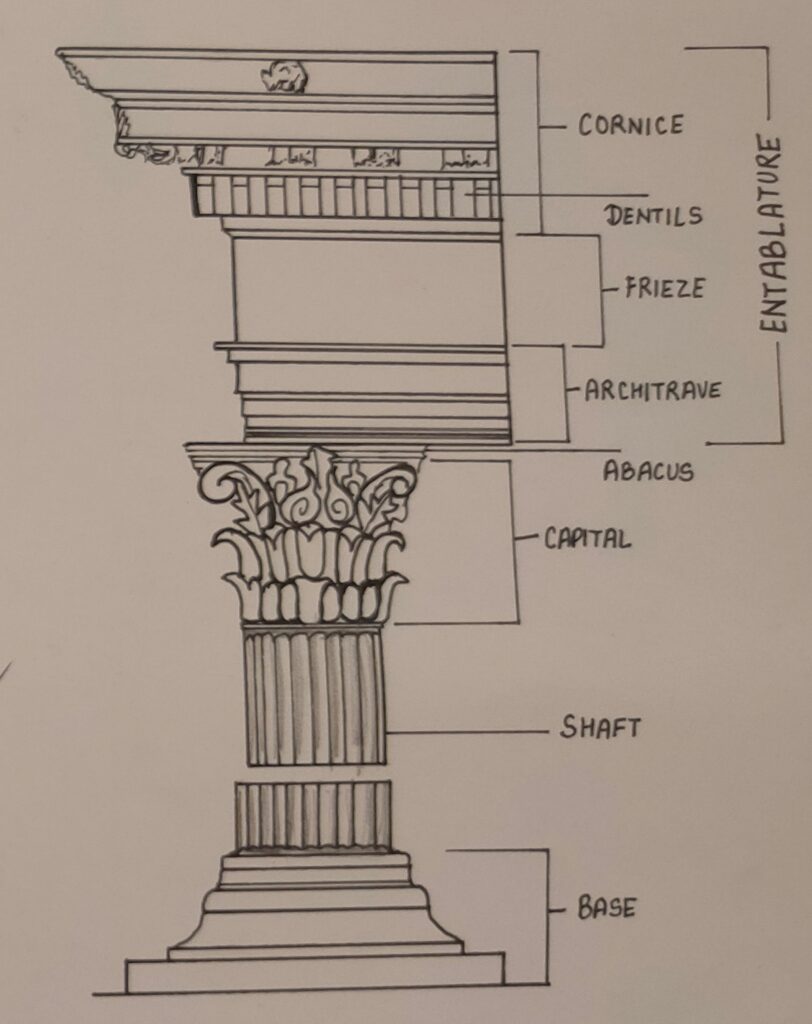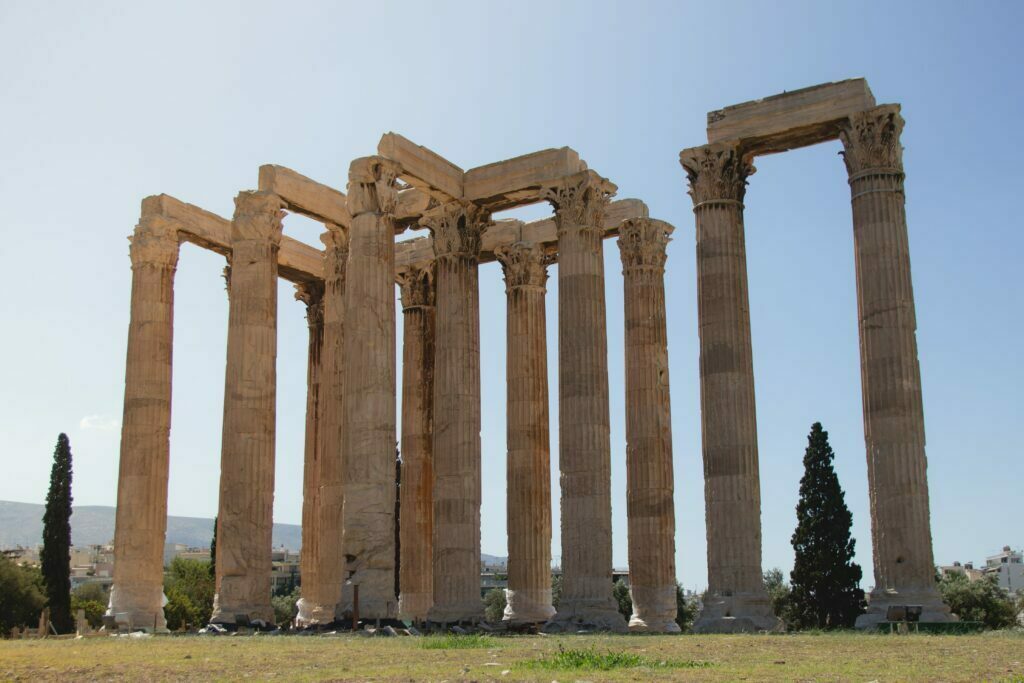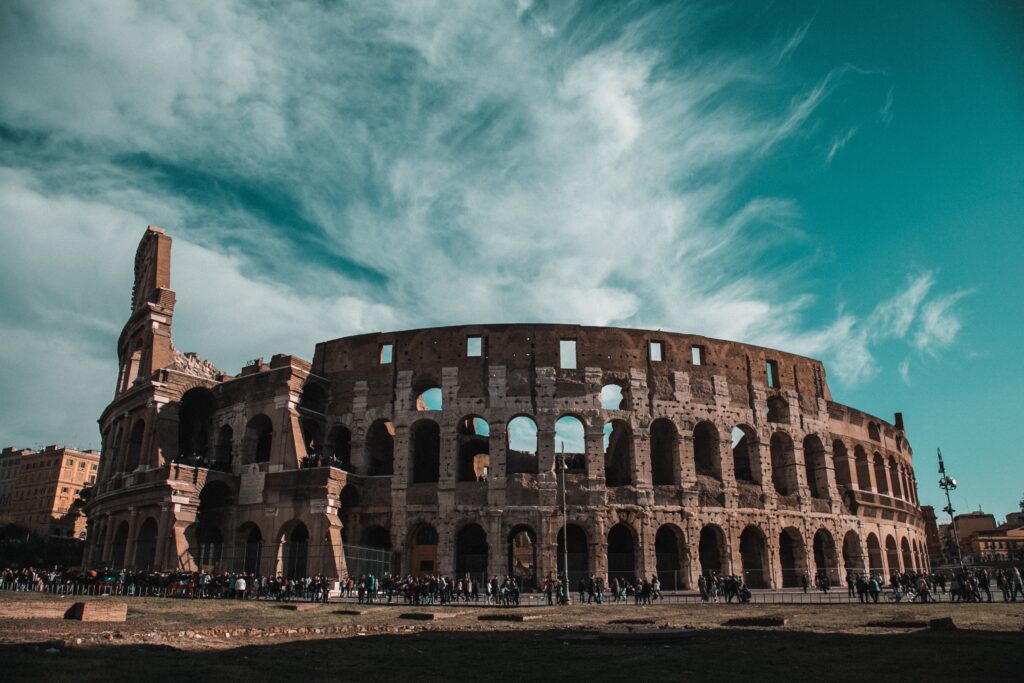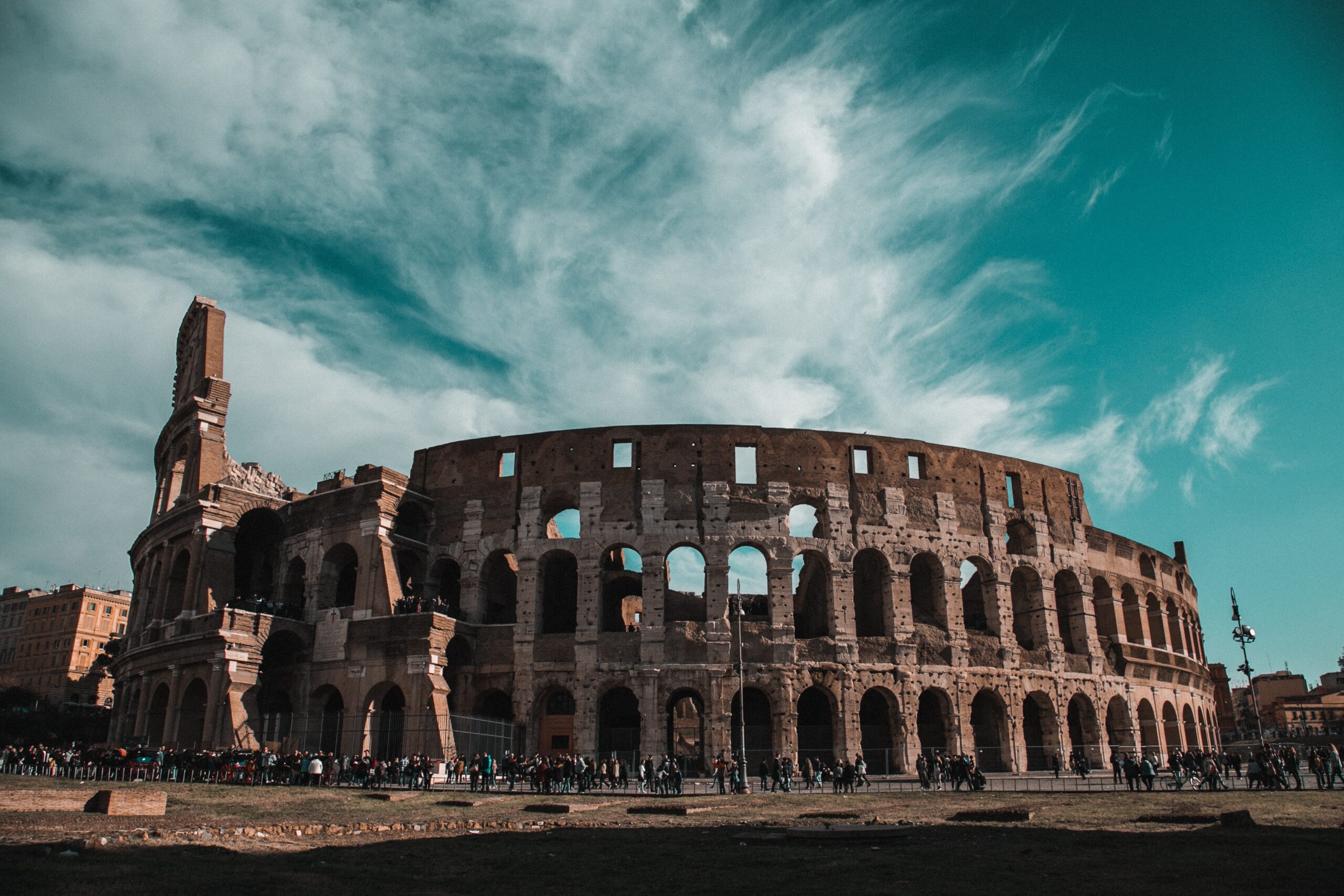Types of Greek Order
- Doric Order
- Ionic Order
- Corinthian Order
Types of Roman Order
- Doric Order
- Ionic Order
- Corinthian Order
- Composite Order
- Tuscan Order

Introduction of Greek Corinthian Order
The Corinthian order is one of three classical orders in ancient Greek architecture; the other two are the Doric and Ionic orders. It is most popular among them because of its ornate designs, elaborate capitals, and top portions that are ornamented with acanthus leaves, small flowers, and scrolls.
The Corinthian order is named after the city or state of Corinth, from which it was connected during that period, and it was first developed around 430 BC. [1][2]
The Greek classical order is distinguished from others in the sense that the different forms are brought under a definite set of rules. [3]

Sketch by Shivani Lohiya
The Greek Corinthian Order
The order is taken from the “Choragic Monuments of Lysicrates.” It was constructed in 335 B.C. at Athens to celebrate the victory in a Choragic contest.
The monument dedicated to Dionysos by Lysicrates (a Choragos) stands on a square base and is cylindrical with six columns that support an elaborately sculpted entablature.
(i) Column: The column, including the base, shaft, and capital, is about ten times its lower diameter in height. The base is semi-diameter high, like the Ionian Order, with its upper and lower torus separated by scotia and fillets. The lower torus is 1 whole 1/3 times the diameter of the shaft.
The shaft is circular and tapered to 5/6 of its diameter at the top. It has 24 flutes with separate fillets, which are nearly one-fourth the width of the flutes. The intercolumniation is in three dimensions.
The Corinthian Order has a distinctive capital that is much deeper than the Ionic, being about 1-1/3 in diameter high. Its origin is uncertain, but it might have evolved from the Egyptian bell-shaped capital, or as Vitruvius records, the capital was due to Callimachus, a famous Athenian sculptor in bronze, who got the idea from seeing a basket covered with a tile kept over the tomb of a Corinthian maiden; the basket is placed on the root of an ‘acanthus plant, its stem and foliage being turned into volutes at an angle of the tile.
The usual type of capital has a deep inverted bell shape, the lower part of which contains two rows of eight acanthus leaves resting on a lotus or water leaf, and in the upper part, eight ‘caulicoli’ (caulis = a stalk) rise in between the leaves of the upper row. Each caulicali is surmounted by a calyx, from which spring small volutes support the corners of the moulded abacus and the central foliated ornaments. Each face of the abacus containing ‘a rosette’ in the centre is cut at an angle, and it fully covers the bell of the capital.
(ii) Entablature: The Corinthian entablature, which is usually 2 whole 1/4 diameters high, bears a close resemblance to the Ionic Order. It contains the following:
(a) Architrave: It is ¾ diameter-high and is divided into three fasciae, i.e., three slabs raised one above the other with slight projections.
(b) Frieze: It is also ¾ diameter-high and ornamented by a continuous band of sculptures.
(c) Cornice:- It is lighter than other types. It is also ¾ diameter-high and contains teeth below the corona. At the top, an “Antefixal” ornament is provided.
The Greek Corinthian Order was chiefly used as a decorative feature and was little used by the Greeks. This order is lighter and more delicate than either the Doric or the Ionic.[3]

Proportioning of Greek Classic Orders
The following table shows the proportioning of the Greek Orders.[3]
| Name of Greek Order | Height of column in terms of lower Dia. | Height of Entablature in Terms of lower Dia. |
| Doric | 7 | 2 |
| Ionic | 9 | 2 |
| Corinthian | 10 | 2 whole 1/4 |
Introduction of Roman Corinthian Order
The Roman version of the Corinthian order is similar to the Greek version, but with some distinct differences. The Roman Corinthian capital is typically more ornate and elaborate than the Greek version, with more intricate detailing and a greater emphasis on realism. The Roman column shaft is also usually more slender than the Greek column, and the base of the column is often more decorative.
The Roman Corinthian order was used extensively in Roman architecture, particularly during the Imperial period. It can be seen in many important Roman buildings, including the Pantheon and the Temple of Castor and Pollux in the Roman Forum.
The Roman Corinthian Order
The order is taken from the Temple of Castor and Pollux at Rome (7 B.C.–A.D. 6). It is rectangular in plan
(1) Column:- The column, including the base, shaft, and capital, is 10 times its lower diameter in height.
The semi-diameter-high base consists of a simple square block with an upper and lower torus separated by a scotia and double bead.
The circular shaft is either plain or fluted, with 24 flutes separated by fillets that are one-third the width of the flutes. The column tapers to 5/6 diameter at the top. The Intercolumniation is 2 whole 2/3D.
The capital, which is 1 diameter high, is the most distinguished feature. The capital resembles that of an inverted bell, consisting of two rows of acanthus leaves. The first row, which starts directly above the astragal of the shaft, consists of eight small acanthus leaves. In between these small acanthus leaves, stems of large acanthus leaves rise. In the upper part, in between the larger leaves, spring eight cauliflowers, each surmounted by a calyx, from which rise sixteen volutes. The eight small volutes roll in pairs towards the centres of the four sides of the abacus, while the eight larger ones support, also in pairs, the four corners of the abacus. The abacus has hollowed sides, and its faces are cut at an angle.
It is enriched with floral design and also with a central ornament called a “rosette.” The lip of the bell slightly projects beyond the face of the abacus. The acanthus leaves in Roman Corinthian appear more natural.
The Romans used the acanthus leaves in a highly convenient manner to develop the Corinthian capital to its perfect form.
(ii) Entablature:- The Roman Corinthian has a distinctive entablature that is two and a half diameters high and contains the following:
(a) Architrave:- The architrave, which is ¾ diameter-high, consists of three fascia’s separated by ornamental mouldings.
(b) Frieze:- The frieze is also ¾ diameter-high and is enriched with acanthus scrolls and human or animal sculptures.
(c) Cornice:- It is one diameter high. The cymatium is enriched with acanthus leaves and has water spouts at regular intervals in the form of lion’s heads to drain out rainwater. The cornice has dentils and contains “egg and dart’ mouldings. It is supported by a series of beam-like brackets called ‘modillions,” which is a special feature of this order. The lower side of the modillion is covered with an ornamental leaf. Sculptured coffers are placed in between the modillion, which can be seen below. The projection of the cornice is equal to its height, or one diameter.[3]

Proportioning of Roman Classic Orders
The following table shows the proportioning of the Greek Orders.[3]
| Name of Roman Order | Height of column in terms of lower Dia | Height of Entablature in Terms of lower Dia. |
| Doric | 8 | 2 |
| Ionic | 9 | 2 whole 1/4 |
| Corinthian | 10 | 2 whole 1/2 |
| Composite | 10 | 2 whole 1/2 |
| Tuscan | 7 | 2 whole 1/3 |
Characteristics and Features of Roman Corinthian Order
The Corinthian order is characterized by the following features:
Capital: The Corinthian capital is the most distinctive feature of the order, with its intricate decoration of acanthus leaves and scrolls. It is shaped like a bell or a reversed bell, with volutes (scrolls) at the four corners and acanthus leaves at the center.
Column: The Corinthian column is slender and fluted, with a slight swelling near the base. It is usually more slender than the Doric or Ionic columns.
Entablature: The entablature of the Corinthian order consists of three parts: the architrave, frieze, and cornice. The architrave is a plain, flat beam that rests on the columns, while the frieze is usually decorated with relief sculptures. The cornice is the topmost part of the entablature, projecting outward and often featuring elaborate moldings.
Ornamentation: The Corinthian order is known for its elaborate ornamentation, particularly on the capital. In addition to the acanthus leaves and scrolls, the capital may also feature small figures or animals. The entablature may also be decorated with relief sculptures or other decorative elements.
Proportions: The proportions of the Corinthian order are typically more slender and elegant than the other two classical orders. The column is usually around 10 times its diameter in height, and the entablature is around one-third the height of the column.











